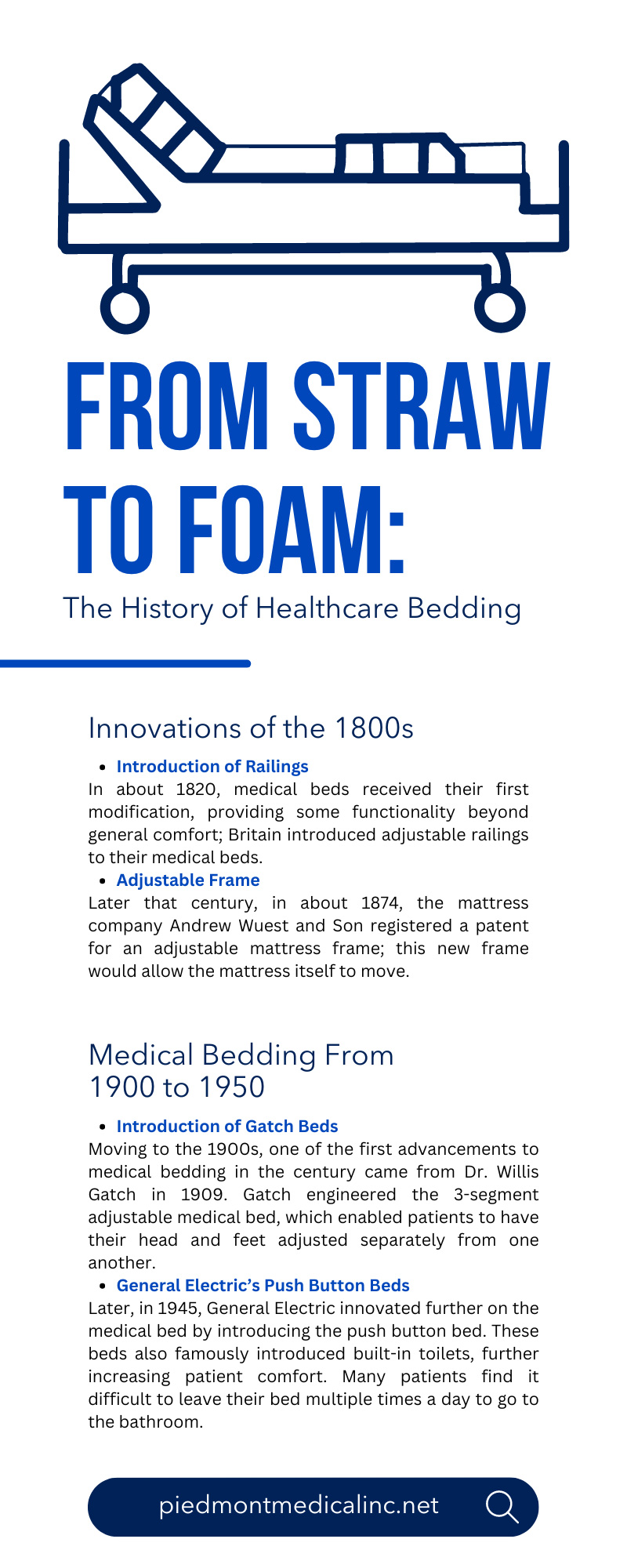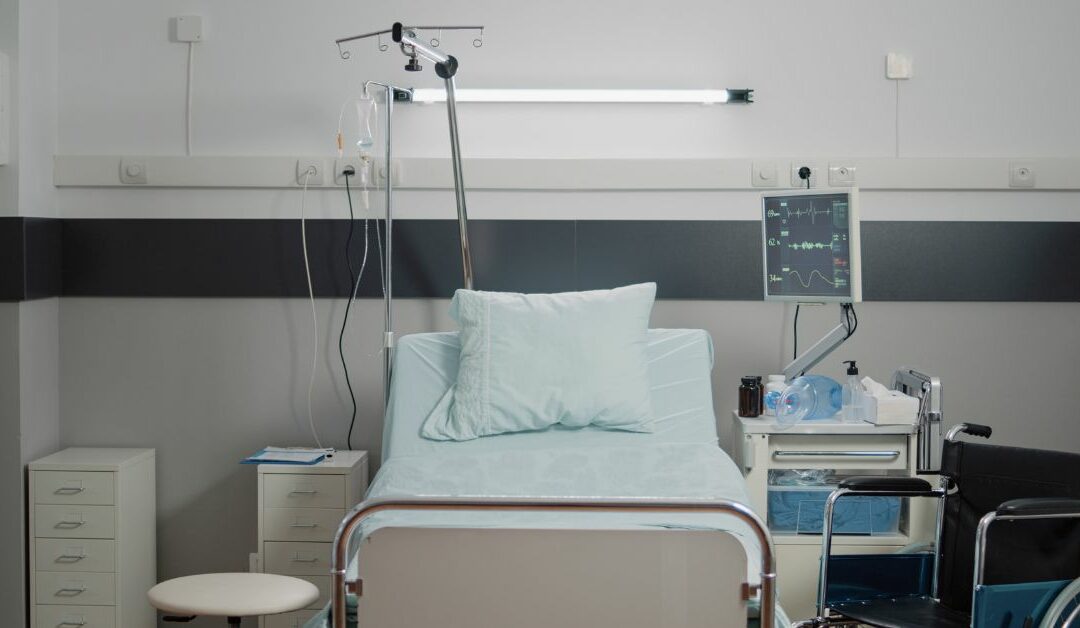Modern medical bedding is something that many may not think about, as it’s something that comes standard with every hospital and a piece of equipment that every patient should expect. Despite how necessary these specialized beds are, many may take them for granted.
The history of medical bedding is a long one that dates back to the 1800s, and there were many innovations and iterations along the way to get the beds to where they are today. Hospital beds weren’t always so specialized—in fact, their first iteration was nothing more than something you’d find in your own bedroom.
What Old Medical Bedding Looked Like
To start our journey of the modern medical bed, we look to the early nineteenth century, a time when medical bedding was plain and rudimentary. Generally, there wasn’t anything special about medical beds at the time—they were largely ordinary beds that ordinary citizens would have in their homes.
Typically, they wouldn’t have railings, adjustable options, or anything beyond a mattress, sheets, pillows, and covers. While these beds did provide general comfort, they didn’t have any modifications or adjustable characteristics to account for specific injuries; patients had the same bedding, no matter their specific needs.
Innovations of the 1800s
Introduction of Railings
In about 1820, medical beds received their first modification, providing some functionality beyond general comfort; Britain introduced adjustable railings to their medical beds. One could adjust these railings with a hand crank to move them up and down. While simple in concept, these railings provided added safety to patients, preventing them from accidentally rolling off the bed and injuring themselves further.
Adjustable Frame
Later that century, in about 1874, the mattress company Andrew Wuest and Son registered a patent for an adjustable mattress frame; this new frame would allow the mattress itself to move. This advancement made it easier for individuals to get on and off the mattress. Those with mobility issues could now lower the bed, decreasing the height and allowing them to safely lay down instead of needing to climb up to the mattress.
Medical Bedding From 1900 to 1950
Introduction of Gatch Beds
Moving to the 1900s, one of the first advancements to medical bedding in the century came from Dr. Willis Gatch in 1909. Gatch engineered the 3-segment adjustable medical bed, which enabled patients to have their head and feet adjusted separately from one another. Prior to this, the whole bed adjusted as one, offering no dynamic positioning.
General Electric’s Push Button Beds
Later, in 1945, General Electric innovated further on the medical bed by introducing the push button bed. These beds also famously introduced built-in toilets, further increasing patient comfort. Many patients find it difficult to leave their bed multiple times a day to go to the bathroom. However, General Electric’s improvement allows individuals to comfortably use the bathroom without having to leave their bed.
Howard Hughes’ Influence
Interestingly, twentieth century billionaire Howard Huges played a role in the advancement of medical bedding. In 1946, Hughes was involved in a plane crash which required him to be in hospital for a time. That said, Hughes wasn’t satisfied with the level of comfort his medical bed provided, so he took time to devise improvements for his bedding. As the story goes, Hughes utilized a 6-section bed and 30 electric engines to run it.
While Hughes’ meticulous over-engineering of his own hospital bed may not have instantly revolutionized the medical industry, it did push the idea of greater patient comfort. It opened the conversation of how medical bedding can go even further to facilitate comfort and recovery.
Basic Control Functionality
Up until now, individuals have had to manually adjust medical bedding. Adjusting beds would often fall on the nurses as their responsibility, as many patients wouldn’t be able to do it themselves. But 1949 was the year that introduced basic controls for patients to adjust their own beds without the assistance of medical staff, providing them a means to manage their comfort.
This technology would see refinement in the coming years—first in 1952 by the company Hill-Rom, introducing an electric engine, and again in 1956, which was fully electrical.
From 1950 to the Present day
Greater Control for Patients
The second half of the twentieth century saw even more innovations within the realm of medical bedding, initially with increased control functionality for patients to utilize. In 1961, manufacturers started equipping beds with remote controls for patients to further adjust their own beds without the help of medical staff. And in 1974, manufacturers installed a control panel on the side railing providing an easier means for the medical team to adjust the bed as needed for their purposes.
A Wider Array of Mattresses
While the frame of the medical mattress saw a lot of innovation over the century, manufacturers began looking for ways to improve the mattress itself. Medical bed mattresses began seeing new iterations, some coming with monitors to weigh patients without needing them to leave their beds. This time also saw the rise of therapeutic mattresses, with medical professionals trying different mattress materials for different patients and adjusting the mattress itself to the patient’s needs.
Home Use
The 1980s were also the time when individuals could place hospital-grade medical bedding within their own homes; hospital beds were no longer limited to the hospital. This change allowed for greater comfort for patients receiving home care, providing them with all the benefits and comforts of a hospital bed at home.
Even More Control Functionality
Finally, we find ourselves in the 1990s, which introduced even greater control over medical bedding, allowing patients to adjust their position as needed from a remote attached to their bed. Whether they want to elevate their head, lower their legs, decrease the height of their frame, or increase it, mattresses and frames were now more convenient than ever for patients.
From Ordinary Beds to Medical Devices
In their infancy, medical bedding was no more complex than the average bed in a hotel room. However, due to the innovations of medical professionals and manufacturers, medical bedding now provides far greater comfort and convenience than ever before. From simple origins to foam mattresses, the history of medical bedding has been long and punctuated with many improvements, resulting in the modern marvels of engineering we see today.



Recent Comments